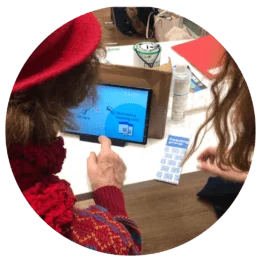
The bespoke cardboard stand we created was useful for holding the iPad at a good angle for participants to join the call and to hold the Zoom Ticket in the correct position. It is not, however, necessary to use this stand. Instead, an off-the-shelf stand could be used to hold the tablet during the call and the tablet could be picked up and pointed at the Zoom Ticket on a table.
Each group session started with five or six participants but not everyone attended. 3-5 participants seems to be a good number as it gives each person the opportunity to talk and makes it possible to manage people talking over each other.
Having fewer than six people in total on the screen (including hosts) allows everyone to be visible in grid view and is not too overwhelming for participants. Having more than six people on the call would spread people over two screens and participants may find it difficult to manage.
It can be harder to predict group sizes due to last minute changes depending on individual circumstances on the day. Smaller groups are more feasible to manage when considering the personalised support required to run the session, including reminders prior to the sessions and getting to know participants on a 1:1 basis.
We set aside one hour for each session and finished promptly so as not to tire our participants or let the quality of the experience deteriorate. The sessions worked very well when they had two distinct sections, typically a general conversation for 25-30 minutes followed by an activity for 20-30 minutes. The change of pace between these two phases helped people stay engaged and prevented the activities from dragging. Our participants seemed to remain engaged for the full hour.
In order for people to build social connections, it was important to encourage participants to chat to each other during the online groups. This was best facilitated by asking an open question, such as ‘What is your favourite thing to do/eat/possess?’ or ‘What are you looking forward to at the moment?’. Asking some follow-up questions and getting to know the participants encourages them to talk more and encourages other participants to chip into the conversation. Ideally, the facilitator will be needed little and participants will talk amongst themselves.
To maximise the chance that participants will feel comfortable and happy during the sessions, it is important to help them understand what to expect (e.g. how long the discussion section will last and what activities the session will include). A good way to do this is by sending a note in the post and/or talking about it at the end of the previous session. Participants then have the option to not attend a particular session if it does not appeal to them.
It is also useful to reorientate participants at the start of each session and remind them what the session will involve. We found it helpful to simply lay out:
Routine is incredibly important for many people living with dementia so having a clear structure and framework for the online groups was highlighted as a priority. This is not just to help the person living with dementia but also the carers who need to fit the pilot into their lives, particularly if they do not live with the person they care for or are working alongside their care role.
It is important to create a safe and moderately-paced environment that allows people to speak and engage in their own way. In practice, this means allowing pauses in discussion, being flexible about the timings within the sessions and allowing participants who may take longer to speak to do so.
Many participants said they preferred getting to know people on a 1:1 basis rather than going straight into big groups. This included comments on the benefits of meeting members of our team in person during installation visits, which created a sense of connection before joining the group calls. Some participants suggested that getting to know other participants and team members individually would have made the group activities easier for them.
Take time getting to know the individual participants, including their likes and dislikes and their personal circumstances. This was primarily done through the 1:1 sessions with members of our team, where participants commented on how their feedback was listened to and acted upon immediately, with changes being seen in the next sessions. Adaptability according to personal preferences is not always possible but a willingness from staff to try was noted and appreciated by participants.
Most participants in the pilot had someone living with them who was able to support them using the iPad. One participant who did not have this kind of support did not use the iPad or join the groups during the pilot. They had a smartphone but did not keep it charged so attempts to provide additional support were, unfortunately, futile.
With more time to recruit participants in partnership with existing community groups (rather than forming groups specifically for the pilot), we recommend testing the kit with more people who live alone to better understand how to support them.
With more time, additional steps could be taken to refine how intuitive it is to use the Digital Befriending Kit and therefore increase the likelihood that people living with dementia could join calls without the support of a carer. For example, we could experiment further with fixing the iPad to the stand (e.g. with velcro) because the stand was often left in a prominent position in the home but the iPad had been removed and hidden. This would also alleviate the challenge some users had of lining up the iPad on the stand.